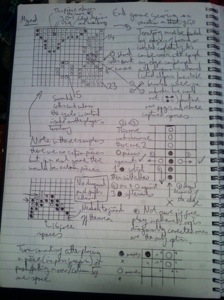Update
You can now play GTBM online at Taebl but you will need a copy of the GTBM.taebl file. Note this needs Silverlight, and humans will need to moderate the rules.
My first submission (actually two!) for #1GAM
I intend to computerise the games at some point, but haven’t locked down a decent A.I. algorithm yet, good enough for solo play/learning. You will need a checkers/draughts/chess/othello/reversi board and pieces for “Get thee behind me…” (or GTBM for short), and a GO board or one of The Viking Game variants for “Mynd”. Coloured counters and a drawn paper board will also work; I got 1000 tiddlywinks in 5 colours for £6 off eBay from SuppliesForAll.
“Get thee behind me…”
Credit is due to former games students, Matt and Dave, for inspiring this mechanic several years ago.
GTBM rules
Each player starts with 8 pieces (white or black) on the nearest row of an 8×8 square board. (Optionally, 16 pieces of each colour on a 16×16 sized board is possible.) Black starts.
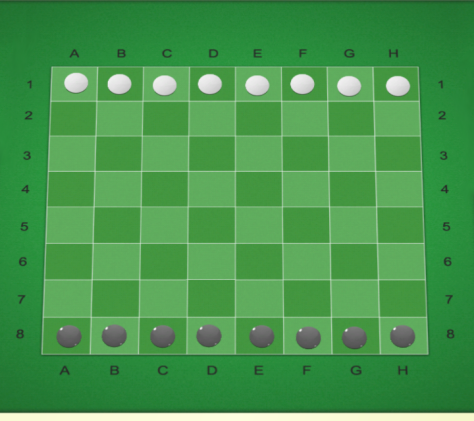
GTBM Starting set up
Pieces can be moved diagonally forward left or right or straight back.

The bottom left Black piece cannot move forward right or to the rear.
If a diagonal move gets a piece behind an opponent’s piece – i.e. between the piece and its owner – that piece is removed. Taking is not allowed when moving straight backwards (no backstabbing!).
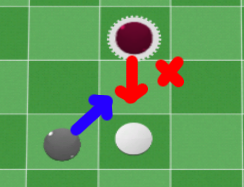
Blue take is legal, but Red isn’t because that piece was not moving from the side.
The game ends when a player cannot make a legal move; if the other player can move they win, but if there is no legitimate move it is a draw. Alternatively, if all a player’s pieces are captured, and the opponent still has a legal move afterwards, then this too is a victory.
One obvious strategy is to build columns of pieces, as these cannot be taken easily. However, the “two steps forward, one back” philosophy may be useful. Below is an example of attrition, where Black is almost certainly going to lose a piece, because White has a partial vertical line protecting the threatened piece.

Black cannot take, but White can
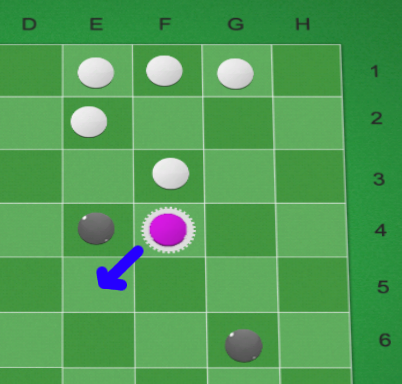
Nothing can prevent Black from being taken, but there is an option to enact tit-for-tat

Defensive play to ensure take and retake
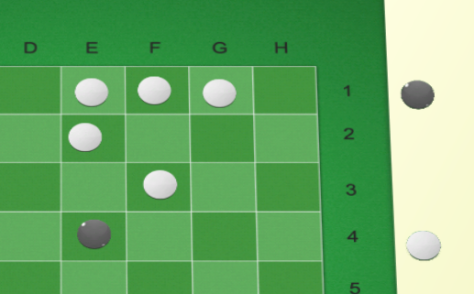
Swap of pieces complete
Please leave feedback on GTBM in the comments below, or over at http://onegameamonth.com/

“Get thee behind me…” and “Mynd” (part 1 above) and “Mynd” (part 2 below) – notes from my #1GAM project book
“Mynd”
This was an attempt at making a “classic abstract” game using a existing board and pieces (in this case, GO and, for the record, “mynd” is Welsh for “go”), rather like Arimaa did with Chess. Also fortuitous was picking up a super cheap, mint copy of Pegity in a charity shop yesterday for £3, which gave me some lovely wooden peg pieces (~200 in four colours 🙂 with a cheap thin card board 🙁 but nothing’s perfect). So, my plan to use Tiddlywinks and a GO board was not needed. Of note, however, is the 16×16 board, rather than 19×19, which is more akin to The Viking Game that has 8×8, 11×11 and larger variants. Basically, the larger the board, the longer and more complex the game, so 11×11 will be best suited to learning the basic tactics, but 16×16 or 19×19 will offer more opportunities. The number of required counters of each colour will depend on the size of the board, but a rule of thumb would be the total number of all the coloured counters should be about two thirds the size of the board – 20 for each player for 11×11, 43 for 16×16, 60 for 19×19. NOTE: These may need adjusting after playtesting. GO has 181 black and 180 White counters, which is sufficient to cover the whole board, even though it is unlikely that players would do so.
Mynd rules
Depending on whether 2, 3 or 4 players are playing, each player starts with one coloured peg in the corner (or, for one of 3 players, the opposite edge) of the board (see sketch above). After that play consists of one of four actions:
- (optional) Placing a piece in any available space – freeform movement called “sowing a seed”
- Placing a piece in any free space (including diagonally) next to an existing piece of the same colour, provided that it has an empty space next to it in an adjacent row, column or diagonal – called “growing the twig” or if this dissects an existing diagonal connection of the opponent’s colour it is called “cutting the bark”
- Pushing a continuous row or column of pieces by one space, provided that the total number of your pieces outnumbers those of the opponent – this is called “extending the branch”
- Placing or pushing pieces such that an area contained by a continuous line of pieces (and/or the edges of the board) is captured, which includes the first corner piece at the start of the game, or in a self-contained cell in the interior of the board – this is called “forming the trunk”
The first case allows players to use pieces to grow into new territory or reduce the final score for opponents. The second case is for growing or adding to the defence of their boundary markers, but also allows for a single piece to be slid along a row or column. In the third case, pushing the pieces along a row may upset the balance of connected columns. However, a row/column may not be pushed in a direction where a piece would be pushed off the board; so edges and corners are particularly useful. Finally, the fourth case is for scoring, the area contained by counting unoccupied spaces inside a completed boundary, excluding pieces of other players, will contribute to the final score.
Play continues until players agree there are no moves left that do not result in a cycle of play that results in a board position being repeated. Alternatively, play can stop upon agreement by the players. Then the unoccupied area of each player is calculated. Areas surrounded by one player’s counters, if subsequently surrounded by those of another, will not count towards either player scores.
Please leave feedback on Mynd in the comments below, or over at http://onegameamonth.com/
